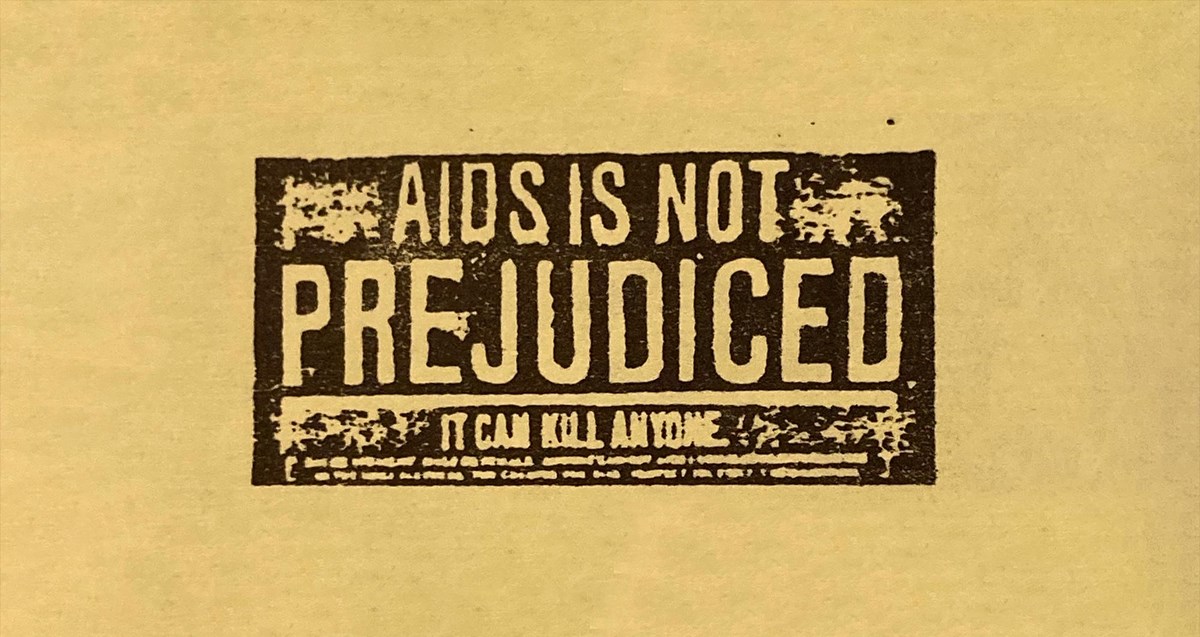
Reading Time: 11 minutes
Long readWritten by Carmen Hesketh

Our collections reveal Scotland’s complex HIV and AIDS history. From grassroots activism to medical advancements, Carmen Hesketh explores the voices and stories that challenge stigma and celebrate resilience.
In 2023, the Library put together an exhibition called 'Blood, Sweat and Tears: Scotland's HIV Story'. This was in collaboration with Waverley Care, a charity supporting people living with Human Immunodeficiency Virus (HIV) and Hepatitis C. 'Blood, Sweat and Tears' marked the first time we had ever co-curated an exhibition on such a scale with another organisation. It was so successful, that it has encouraged the Library to create future displays with input from other communities too.
One of these was the 'People and Power' case in our Treasures Gallery. It was curated by the Library's LGBTQ+ Staff Network and showcased a wide range of our LGBTQ+ history collections. Read more about that and the Glasgay! arts festival in my previous article.
AIDS prevention and medication
Among the documents on display was a public health leaflet on AIDS prevention. It came with two free samples of Acquired Immunodeficiency Syndrome (AIDS) medication that could be taken "up to once daily". As a national library, we hold lots (literally millions!) of traditional books, but we also have many other wonderful items you might not expect to see in a library collection. Including this one.
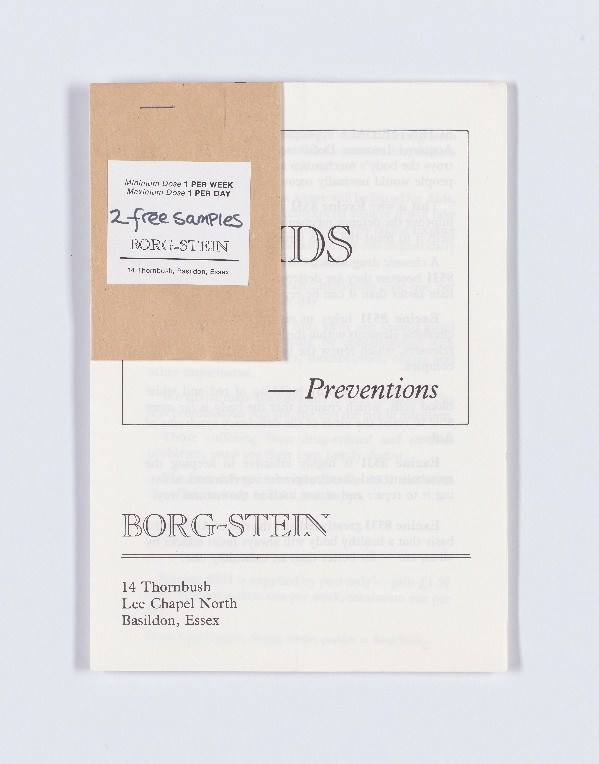
'AIDS – Preventions' Borg-Stein leaflet. Acc.12766/18.
HIV and AIDS is a significant part of modern LGBTQ+ history. Many queer people, particularly gay men, were diagnosed with the conditions when cases began to rise rapidly in the early 1980s and 1990s. Other marginalised communities have also been affected. These include injecting drug users, people of colour, women, and people with chronic health conditions like haemophilia. They have been disproportionately impacted by the conditions and continually face barriers when trying to access health treatment.
The drug samples that came with the 'AIDS – Preventions' pamphlet reminded me of the Channel 4 TV programme 'It's A Sin' (2021). This show tells the story of a group of friends navigating the AIDS crisis in 1980s London. When one of the characters in the show receives an AIDS diagnosis, they drink battery acid, which was rumoured at the time to cure the condition. Both 'AIDS – Preventions' and 'It's A Sin' tell an important wider story of how people diagnosed during this period tried to take treatment into their own hands at a time when the conditions were heavily stigmatised and misunderstood.
The history of HIV and AIDS in our collections
Scotland's HIV and AIDS history is often overlooked. This is despite Edinburgh once being known as the 'AIDS capital of Europe' due to the high number of individuals affected in the city. We hold many items relating to HIV and AIDS at the National Library of Scotland, but we don't have a specific HIV and AIDS collection. The history of the conditions is so all-encompassing, especially during the end of the 20th century. Their impact can be found everywhere.
HIV and AIDS is represented in formal publications like medical journals, government legislation and newspapers. But they are also found in grassroots and creative titles such as poetry anthologies, children's books and ephemera. As a Legal Deposit Library, we are entitled to a copy of every book that's ever been published in the UK, so some of these publications may have been collected this way. However, for grassroots items (especially those with a very small print run and audience), we actively look for these items to ensure that we fill any gaps in our collections. Or we receive them from donors who often belong to a marginalised community themselves.
Grassroots collections can provide us with crucial information. They offer a glimpse of personal perspectives of HIV and AIDS from people with lived experience of the conditions, many of whom might be no longer with us. Other items in our collection can provide valuable insight into contemporary governmental and public attitudes towards a persecuted community. When looked at together, our HIV and AIDS collections can provide an interesting picture of a nuanced history of the conditions in Scotland, the UK and around the world.
The items I'm discussing make up a small list of examples of what we hold on HIV and AIDS. It is by no means exhaustive. If you want to consult our materials for yourself, items are typically available to view in one of our reading rooms in Edinburgh. If you are interested, you can get in touch with us via our Enquiries Service.
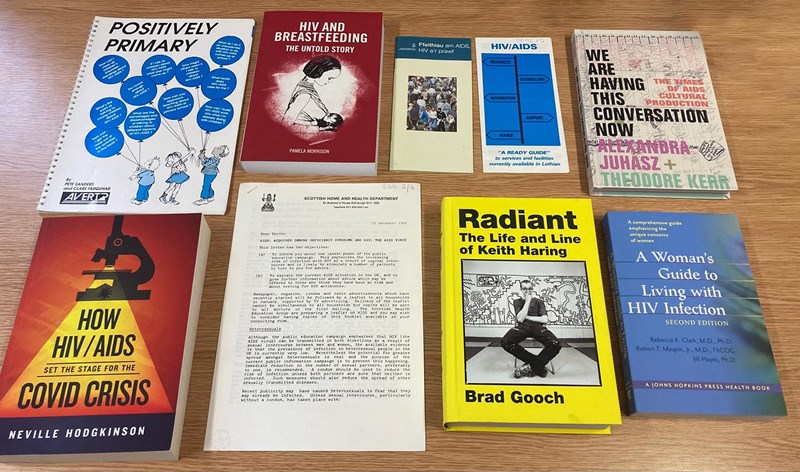
Some of the HIV and AIDS items and ephemera in our collections.
Intersectional discrimination
The first confirmed cases of HIV and AIDS in the UK were from members of the gay community. Many of whom had visited American cities renowned for their gay club scenes, such as New York and San Francisco. At this time, homosexuality had only very recently been decriminalised in Britain. Until 1967, homosexual activity between men was illegal in England and Wales. Scotland didn't decriminalise homosexuality until much later in 1979.
Public attitudes towards queer identities were often discriminatory and it didn't take long for HIV and AIDS to be labelled as 'gay cancers'. In fact, before it was officially called HIV, the virus had been named GRID, or Gay Related Immune Deficiency. At the same time, cases of the conditions began to increase amongst injecting drug users across the UK. This was especially rapid within Edinburgh's Pilton and Muirhouse neighbourhoods where there was a local needle sharing culture.
Many people with HIV and AIDS therefore faced double discrimination. They were discriminated against for their homosexual identity or their injecting drug use practices, and because of their diagnosis. This is clear from our local newspaper collections. 1980s readers wrote in to share their views on communities affected by the epidemic.
An article from the Edinburgh Evening News in December 1986 contains harrowing testimonies from residents, who share prejudiced views towards injecting drug users and homosexuals. While these may have been published by the newspaper because they are so extreme, it nonetheless highlights some of the views held towards these communities during this time.
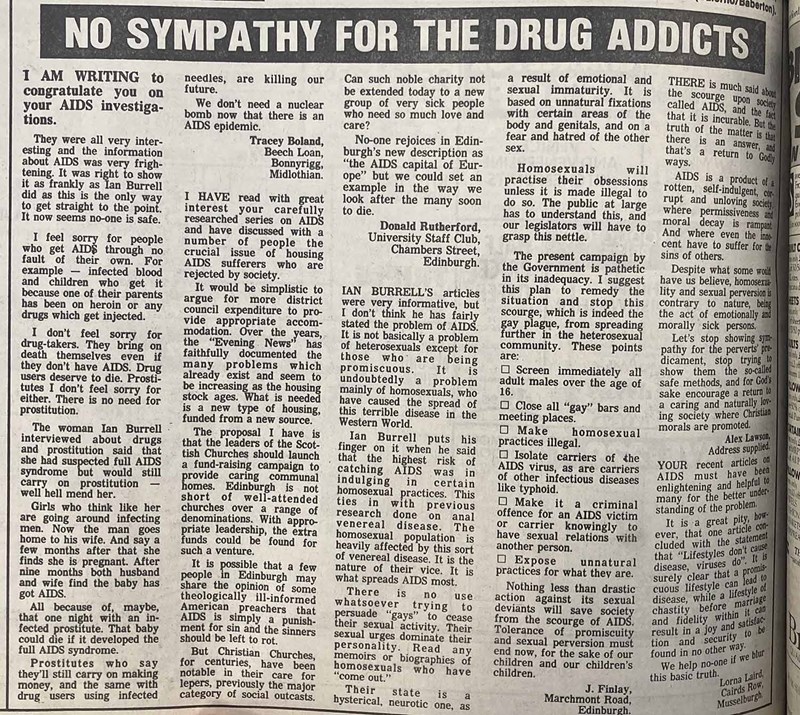
Edinburgh Evening News, 18th December 1986. CB.2/105(4-).
Stoking stigma
The first case of AIDS in the UK was recorded in 1981. It took until 1987 for the Thatcher Government to respond to the epidemic, at which point they released their 'AIDS: Don't Die of Ignorance' campaign. People alive in the 1980s will likely remember seeing the famous 'AIDS: Monolith' and 'AIDS: Iceberg' adverts on television, both of which featured sombre music and fearful imagery such as falling rocks, melting ice and tombstones.
While these adverts undoubtedly raised awareness about HIV and AIDS across the nation, the campaign's dark tone also arguably added to the stigma. The British government's long overdue response also meant that there were many enduring misconceptions about HIV and AIDS. For example, the incorrect belief that the conditions could be spread by simply touching an affected person.
This was the backdrop against which the affected marginalised communities in Scotland and their allies rallied together.
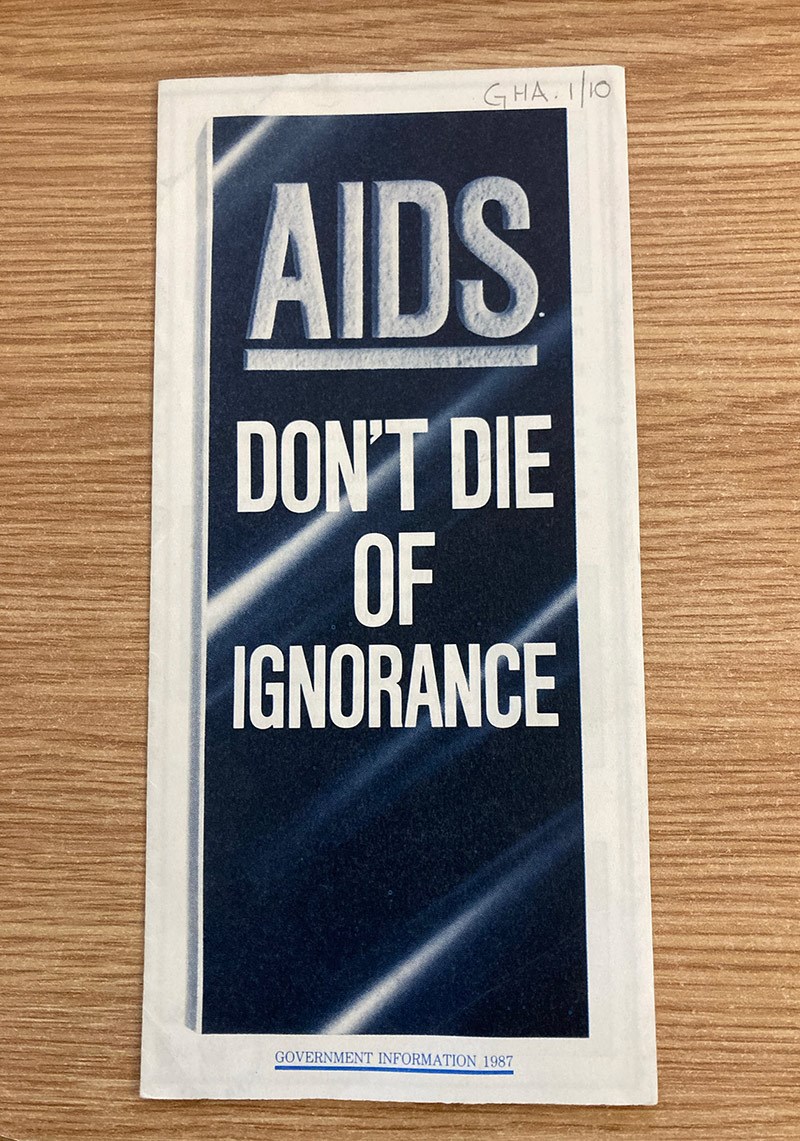
'AIDS: Don't die of ignorance' advert. GHA.1/10.
Grassroots activism and public health campaigns
In response to misinformation and discrimination, communities created grassroots sexual health awareness materials to combat HIV and AIDS transmission. Many of these are in our collection. For example, we hold archival collections of Lavender Menace, Scotland's first LGBTQ+ bookshop.
In the late 1980s, when it was known as West & Wilde and located on Edinburgh's Dundas Street, the bookshop created 'Reading AIDS'. This was a series of reading lists about what was available. They advertised books for sale at their shop that covered important issues like daily living with AIDS and dealing with death and bereavement. Today, Lavender Menace is an archive which records its own history as well as queer history more generally, while also being a safe space for the LGBTQ+ community.
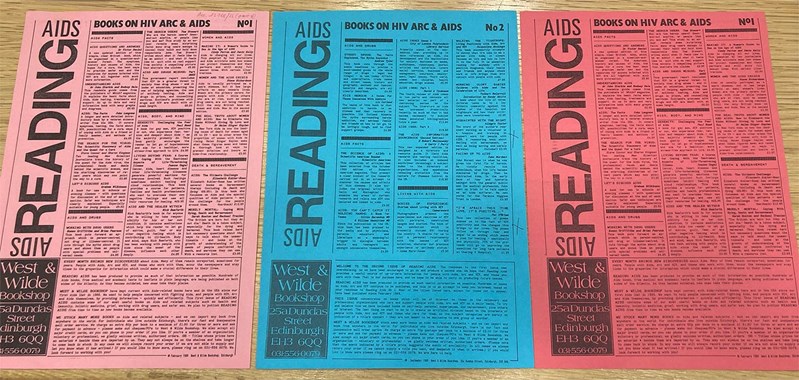
'Reading AIDS' numbers 1 and 2 (Acc.12766/22).
We also hold examples of local authority public health campaigns. Some in Scotland took a more sensitive approach to HIV and AIDS awareness in contrast to telling the public "don't die of ignorance". For example, NHS Lothian's 'Take Care' campaign was launched in 1989 and asked residents to "take care of the one you love", creating a narrative that safer sex practices could be beneficial for your relationship with your romantic partner.
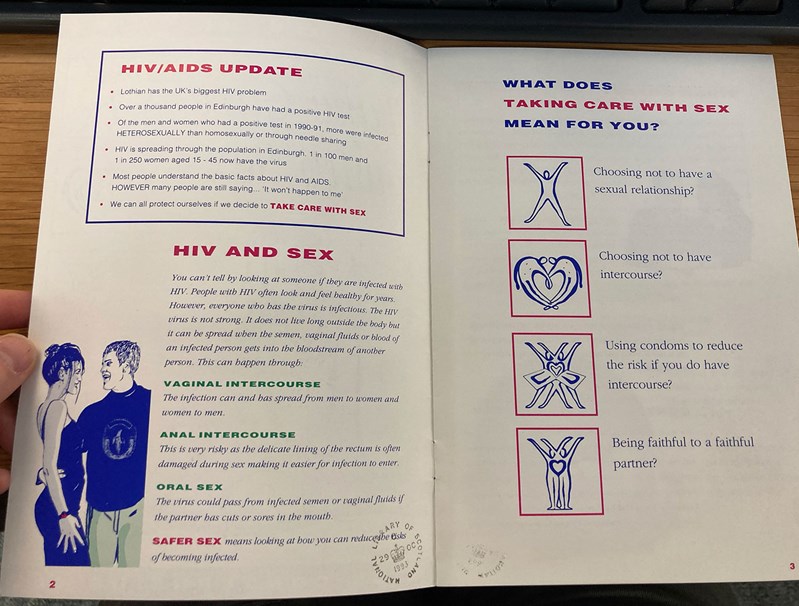
'Take Care' leaflet from around 1990. SJ4.3673[1990?]).
Medical progress
Medical advancements in HIV and AIDS treatment arrived from the late 1980s onwards. First with the use of drugs like azidothymidine (more commonly known as AZT) and then with the introduction of highly active antiretroviral therapy (HAART). This changed what it meant to live with HIV and AIDS across the world, including in Scotland.
The number of people dying from complications of AIDS has continued to reduce dramatically. People with an HIV diagnosis have since been able to live healthier and for longer. Today, many people with HIV are Undectable=Untransmittable (U=U), meaning their viral load of HIV is so low that they can't pass the virus onto others. In 2017, Scotland was also the first UK country to offer pre-exposure prophylaxis (PrEP) medication for free on the NHS, preventing people at risk of HIV from infection.
These incredible developments don't mean our HIV and AIDS collecting has stopped. People in Scotland continue to live with HIV and the stigma and misunderstanding remains. It's important for our collections to reflect this.
Collecting continues
One of my favourite collection items relating to HIV and AIDS in the 21st century is 'Exposed!'. A magazine published by the HIV charity Terrence Higgins Trust, it was distributed in LGBTQ+ bars across the UK in the early 2000s. In an issue from winter 2001, there are a series of adverts promoting unrealistic products, such as "6-pack cream" and "instant hair growth gel". These were designed to highlight that expecting someone with HIV to always disclose their status to new sexual partners is also unrealistic.
I find it particularly interesting how this advert combines humour with important issues, such as gay male beauty standards, and considers the complex reasons why someone living with HIV may choose not to share their diagnosis with others.
Some of our more recent acquisitions relating to HIV show other important perspectives. Last year the library purchased all three books from the 'History Moves' series: 'I'm Still Surviving', 'I'm a Challenger' and 'I'm a Warrior'. These books record oral testimonies of women, mostly women of colour, living with HIV across the United States. Many of the women involved in the project talk about their experiences of poverty, the prison system, and motherhood, giving us a valuable perspective on the diverse range of people affected by HIV.
I put forward this series to be acquired by the Library to fill this gap in our collection. If there are any items that we don't hold that you think we should, please contact us to let us know and we can explore acquiring it for future generations.
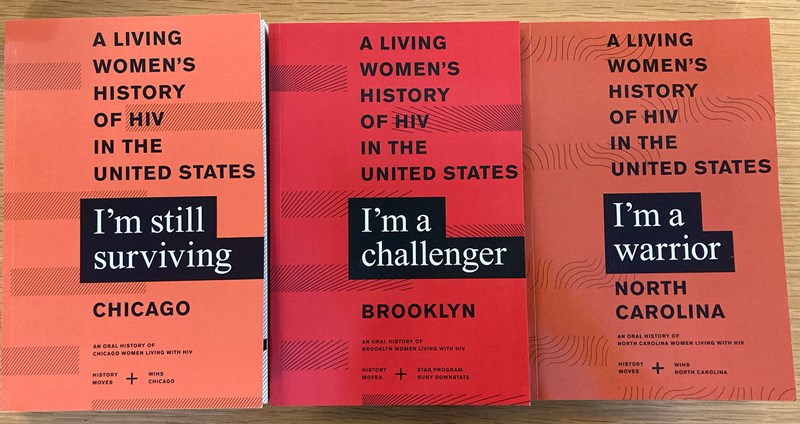
All three copies of the 'History Moves' series. PB8.224.143/9, PB8.224.143/10 and PB8.224.143/5.
In late 2023, as part of the events programme for the 'Blood, Sweat and Tears' exhibition, we hosted a panel event with the authors of 'Our stories told by us: celebrating the African contribution to the UK HIV response'. It was amazing to hear directly from people living with HIV in the UK today. It was also incredibly powerful to get to witness the moment the authors donated a copy of their book to the Library.
I got to see first-hand how HIV collections are continuing to expand. The fact that publications produced by people with HIV for people with HIV are increasingly being represented in our collections is very exciting and crucial to the history of these conditions.
Our HIV and AIDS materials highlight Scotland’s role in a global story of struggle, activism, and progress. From early misinformation and discrimination to groundbreaking medical advancements, these items document the resilience of affected communities and their fight for dignity and care. As the Library continues expanding its collections, the lived experiences of people with HIV remain part of our shared history.
About the author
Carmen Hesketh (she/her) is one of our Special Collections Assistant, where she assists Library readers visiting the Special Collections Reading Room to access our Archives and Manuscripts and Rare Books and Music collections.
Passionate about researching areas of Scottish "history from below" (areas of marginalised history that often slip through the cracks) Carmen's own area of research is about how Scottish cultural organisations like museums and archives sensitively record the nation's history of HIV and AIDS.






